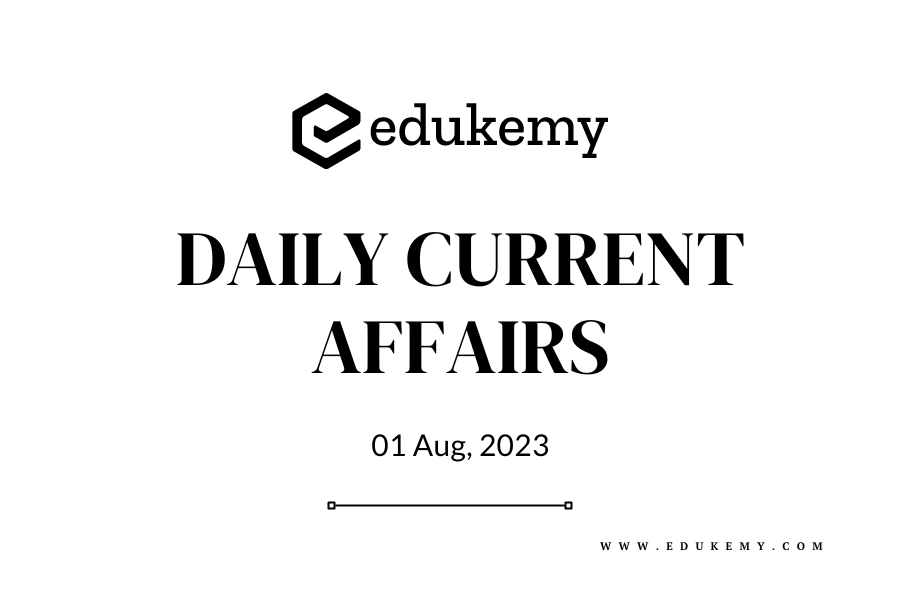


Contents
- 1 Resource Efficiency Circular Economy Industry Coalition
- 2 The State of Climate in Asia 2022
- 3 Gulf Stream and AMOC
- 4 Colombo Security Conclave (CSC) framework
- 5 SemiconIndia 2023
- 6 Ministry of Earth Sciences Initiatives
- 7 Ancient pathogens
- 8 Parkachik Glacier in Ladakh
- 9 Self-Reliant India Fund (SRI fund)
- 10 RBI’s Digital Payments Index (RBI-DPI)
- 11 Lao PDR (Laos)
- 12 Niger
- 13 Papua New Guinea
- 14 Frequently Asked Questions (FAQs)
- 14.1 Q: What are daily current affairs?
- 14.2 Q: Why is it important to stay updated with daily current affairs?
- 14.3 Q: Where can I access daily current affairs information?
- 14.4 Q: How can I effectively incorporate daily current affairs into my routine?
- 14.5 Q: What are some tips for critical analysis of daily current affairs?
Resource Efficiency Circular Economy Industry Coalition
Tag: GS-3, Economics
In News: Recently, the Resource Efficiency Circular Economy Industry Coalition (RECEIC) was inaugurated by the Union Minister of Environment, Forest, and Climate Change.
About: Resource Efficiency Circular Economy Industry Coalition (RECEIC)
- A total of 39 multinational corporations (MNCs) hailing from various sectors such as steel, FMCG (Fast-Moving Consumer Goods), and electronics united to form RECEIC.
- Their collective commitment involves embracing resource efficiency and circular economy principles to tackle environmental issues arising from different types of waste, including plastics, microplastics, e-waste, and chemical waste.
- RECEIC is conceptualized by India’s G20 Presidency, it is envisaged to be industry-driven and a self-sustaining initiative continuing to function even beyond India’s G20 Presidency.
Objective of RECEIC
The coalition’s main objectives are to:
- Promote and encourage collaboration between companies,
- Develop advanced capabilities across various sectors and value chains,
- Leverage the diverse global experiences of its members to drive progress,
- Encourage private sector action to enhance resource efficiency and accelerate the transition to a circular economy.
To achieve these goals, the coalition is organized around three key pillars:
- Partnerships for Impact: The coalition aims to forge strategic partnerships between companies, fostering a collaborative approach towards achieving impactful and sustainable outcomes.
- Technology Cooperation: By promoting technology sharing and cooperation among its members, the coalition seeks to drive innovation and enhance capabilities across industries.
- Finance for Scale: The coalition recognizes the importance of financial support to scale up circular economy initiatives. Therefore, it aims to facilitate funding opportunities to accelerate the adoption of sustainable practices in the private sector.
Significance of RECEIC:
- The coalition will have a central role in promoting partnerships, facilitating technological cooperation, knowledge sharing, and fostering innovation. It will also play a key role in enhancing access to finance by enabling the exchange of insights and best practices.
- The coalition’s efforts will significantly contribute to advancing global goals and priorities set by the G20 and other international forums.
- RECEIC will empower industries to address information gaps and coordination challenges across all G20 members, promoting collaboration and collective action towards a more sustainable and efficient global economy.


Challenges for circular economy in India:
- The circular economy model faces challenges in industries due to supply chain limitations and inadequate incentives to invest in recycling and remanufacturing processes.
- In India, there is a lack of awareness among many people about the concept of a circular economy and its associated benefits.
- India’s existing infrastructure may not be adequately prepared to support a circular economy, with issues such as limited recycling facilities and inefficient waste management systems.
- Additionally, there is cultural resistance in India towards the idea of reusing and recycling products, which hinders the widespread adoption of circular practices.
The State of Climate in Asia 2022
Tags: GS – 3: Environment (Climate Change)
Why in News: Recently, the World Meteorological Organization (WMO) released the State of Climate in Asia 2022 Report. As per this report, Asia is the world’s most disaster-prone region.
Key Highlights of the Report:
- It was released during a meeting of the UN Economic and Social Commission for Asia and the Pacific’s (ESCAP) Committee on Disaster Risk Reduction.
- UN ESCAP (HQ: Bangkok; founded in 1947) is one of the five regional commissions under the jurisdiction of the United Nations Economic and Social Council.
- In Asia, the number of disaster events has decreased in comparison to 2021 (100 disasters in 2021).
- Over 50 million people were directly affected due to 81 weather, climate, and water-related disasters in Asia in 2022.
- However, the effects of such events in 2022 were much more pronounced, with an increase in the number of fatalities, people affected, and economic damage.
- 5,879 Asians died due to natural disasters in 2022. This is almost 55 percent more than the human deaths recorded in 2021 across the region.

Floods and droughts in 2022:
- The economic losses associated with floods in 2022 exceeded the average over the past 20 years (2002-2021).
- This was primarily due to the significant economic losses from floods in Pakistan (over $15 billion), China (over $5 billion) and India (over $4.2 billion).
- The economic losses associated with drought in 2022 ($7.6 billion), which mainly occurred in China, exceeded by nearly 200 percent, the 20-year average from 2002 to 2021 ($ 2.6 billion).
- More than 25 percent of all loss and damage from climate-related disasters such as floods, droughts and tropical storms is associated with the agriculture sector.
The continent of extremes- Asia:
- Asia, the continent with the largest land mass extending to the Arctic, is warming faster than the global average.
- In 2022, the estimated mean temperature over Asia was 0.73°C [0.63-0.78] above the 1991-2020 average, making it either the second or third-warmest year on record, the report said.
- The ocean surface in the region has been warming since 1982. In the north-western Arabian Sea, the Philippine Sea, and the seas east of Japan, the warming rates exceed 0.5°C per decade, roughly three times faster than the global average.
- Over the past 40 years, four glaciers with long-term observations in the High Mountain Asia region experienced mass loss, with an accelerating trend in the 21st century.
- From 2021-2022, Urumqi Glacier No. 1 in the eastern Tien Shan mountain range recorded its second-most negative mass balance (‑1.25 m w.e.) since measurements began in 1959.
- As the ocean warms and expands and glaciers, ice caps, and ice sheets melt, sea levels rise. From 2013-2022, the global average sea level rose at a rate of 4.6 mm per year.
- The rates of sea level rise across most of Asia are higher than the global mean rate over 1993-2022 (3.4 ± 0.3 mm per year).

Way Forward:
- Early warnings are one of the most effective ways of reducing damage from disasters. However, there are still significant gaps to be addressed to strengthen these systems in order to reduce the adverse impacts of hydrometeorological hazards in the region.
- The Agricultural sector is central to all climate adaptation planning.
Gulf Stream and AMOC
Tags: GS – 1: Physical Geography (Ocean Currents), GS – 3: Environment & Ecology (Climate Change)
Why in News: Recently, research found that the Gulf Stream System, known as the Atlantic Meridional Overturning Circulation (AMOC), faces a critical threat of collapse due to unabated global carbon emissions.
Atlantic Meridional Overturning Circulation (AMOC):
- It is the Atlantic branch of the ocean conveyor belt or Thermo-Haline Circulation (THC) and distributes heat and nutrients throughout the world’s ocean basins.
- It drives the Atlantic’s currents and plays a crucial role in determining Europe’s weather.
- It carries warm surface waters from the tropics towards the Northern Hemisphere, where it cools and sinks. It then returns to the tropics and then to the South Atlantic as a bottom current.

The Gulf Stream:
- The Gulf Stream is a powerful ocean current in the North Atlantic Ocean.
- It originates in the Gulf of Mexico and flows north-eastward along the eastern coast of the United States, then across the Atlantic towards Europe.
- It plays a significant role in regulating the climate by transporting warm water and heat from the tropics to higher latitudes, influencing weather patterns and temperatures in coastal regions.
Possible impacts of collapse:
- Climate Regulation: It moderates the temperatures along the eastern coast of North America, keeping the coastal areas warmer in winter and cooler in summer compared to inland regions at the same latitudes.
- Weather Patterns: The warm and moist air above the Gulf Stream can lead to the formation of low-pressure systems, which may develop into storms or hurricanes. It can also contribute to the formation of fog in certain areas.
- Maritime Navigation: It provides a fast and efficient route for ships traveling between North America and Europe, as it aids in faster travel times due to its speed.
- Ocean Circulation: The Gulf Stream is an essential part of AMOC and AMOC plays a vital role in redistributing heat around the Earth and regulating global climate patterns.
Colombo Security Conclave (CSC) framework
Tags: GS-II: International Relations
In News: Government Releases Successful Conclusion of Joint Expedition of Scientists on Colombo Security Conclave
About: Colombo Security Conclave
- Indian National Centre for Ocean Information Services (INCOIS) of the Ministry of Earth Sciences has recently released an overview under the regional framework of the Colombo Security Conclave (CSC).
- The CSC framework is a regional initiative aimed at addressing security and environmental challenges in the Indian Ocean region.
- Participating countries in the CSC framework include India, Bangladesh, Mauritius, and potentially other Indian Ocean littoral states.
- Major highlights:
- The framework will encourage collaboration and cooperation among countries bordering the Indian Ocean to enhance maritime security and address common threats.
- It provides a platform for participating nations to share knowledge, expertise, and resources related to ocean observation, security, and environmental issues.
- It will focus on building capacity in ocean observation and services through joint research expeditions of ocean scientists.
- It will predict and manage changes in the regional environment including monitoring climate patterns and extreme weather events.
- The framework will facilitate the exchange of best practices and advanced technologies for ocean research, data collection, and modeling.
- The CSC framework will help in understanding the oceanic and atmospheric states in the Arabian Sea during critical periods like the summer monsoon.
- Fostering cooperation in the region will also help contribute to the sustainable management and conservation of the Indian Ocean’s marine resources.
- Overall, the collaborative efforts under the CSC framework are expected to lead to better forecasting and services, benefiting all participating nations in the region.
SemiconIndia 2023
Tags: GS-II: Government Policies
In News: Prime Minister of India inaugurates SemiconIndia 2023
About: SemiconIndia 2023
- For a Global Good and a better world India recently welcomed semiconductor industry leaders at Mahatma Mandir in Gandhinagar, Gujarat.
- SemiconIndia aims to catalyze India’s Semiconductor Ecosystem in order to make India a global hub for semiconductor design, manufacturing, and technology development.
- It will serve as a platform for industry leaders to synchronize relationships and share knowledge.
- It showcases India’s semiconductor strategy and policy and aligns it with geopolitics, domestic politics, and private sector capacities to boost semiconductor production in India.
- It puts emphasis on collaborative partnerships for catalyzing growth in the semiconductor sector to boost India’s share in global electronic manufacturing.
- India’s solar power installed capacity has increased over 20 times in the last decade, with a target of 500 GW of renewable energy capacity by the end of this decade.
- Export of electronics and mobile devices doubled in the last 2 years making India a reliable supply chain partner.
- More than 300 colleges have been identified to offer semiconductor courses, producing over one lakh design engineers in the next 5 years.
- However, there is a need for Policy reforms to accelerate the growth of the semiconductor sector, including tax exemptions and incentives for new manufacturing industries.
- Overall, India is poised to play a central role in the global semiconductor industry has potential as a player in semiconductor production in the coming decades.
Ministry of Earth Sciences Initiatives
Tag: GS Paper-2: Government Policies and Interventions.
In News: The Ministry of Earth Sciences (MoES) celebrated its 17th foundation day on 27th July and launched several citizen-centric initiatives to mark this occasion.
About the initiatives of MoES:
New meteorological centers were launched at Imphal, Kohima, Aizawl, and Port Blair.

- A new website for disseminating information was released, including alerts for block-level weather forecasts and advisories to benefit our agricultural community, including farmers, fisherfolk, and livestock rearers.
- The information shall be disseminated in English, Hindi, and regional languages in the future.
- The India Meteorological Department (IMD) will be collaborating with the Ministry of Panchayati Raj.
- A Rainfall Atlas of India from 1971 to 2020 prepared by IMD was released.
- A documentary on ‘Cyclone Warning and Management in India: An End to End System’ was released based on the case studies of the management of cyclones Tauktae (in 2021) and Mocha (in 2023).
- SAMUDRA (Smart Access to Marine Users for Data Resources and Ocean Advisories)
- A new mobile application to provide comprehensive information on all ocean-related services of the INCOIS.
IndOBIS
A new web portal featuring the biodiversity of our Indian Ocean EEZ (Exclusive Economic Zone) was made open to the public.
The portal has been developed by the Centre for Marine Living Resources and Ecology (CMLRE), Kochi.
It is a project under the Intergovernmental Oceanographic Commission (IOC)-UNESCO International Oceanographic Data and Information programme.
- A detailed scientific catalogue entitled ‘Systematic account of Indian deep-water Brachyuran crabs collected during the expeditions of FORV Sagar Sampada’ was released.
- A detailed report of the CAIPEEX IV (Cloud Aerosol Interaction and Precipitation Enhancement Experiment) by the Indian Institute of Tropical Meteorology (IITM), Pune, was released.
- An infographic book entitled ‘75 Years of Earth Sciences in India’ was released to highlight the success story of the growth and achievements of the MoES.
- The first-ever annual report of the National Centre for Medium-Range Weather Forecasting (NCMRWF), Noida, was released.
- A video explaining the 330m Delhi Model, developed by NCMRWF, Noida, in collaboration with international counterparts such as the UK Met Office, was released.
- The high-resolution 330m Delhi model is used to study aerosols, Particulate Matter (PM)2.5, and fog in Delhi NCR and predict visibility in the capital region.
- A Compendium of Monthly Seismological Bulletins for 2021, and 2022, prepared by the National Centre for Seismology (NCS), was released.
Ancient pathogens
Tag: GS Paper-2: Health; GS Paper-3: Biodiversity.
In News: In a new study published in the journal PLOS Computational Biology, the ecological risks, posed by the release of unpredictable ancient viruses, have been calculated.
About the study:
- The simulations show that 1 percent of simulated releases of just one dormant pathogen could cause major environmental damage and the widespread loss of host organisms around the world.
- A software called Avida was used to run experiments.
- In the worst-case scenario, the invasion reduced the size of its host community by 30 percent when compared to controls.
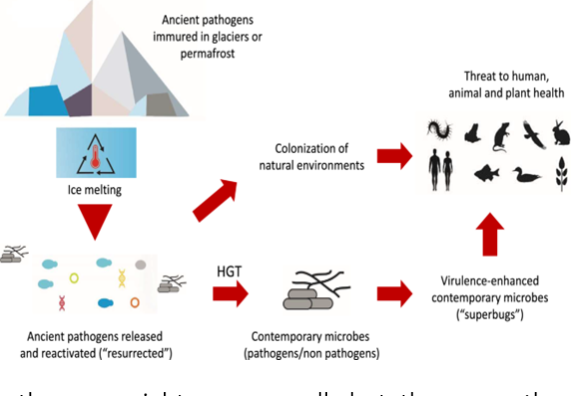
The risk from this small fraction of pathogens might seem small, but these are the results of releasing just one particular pathogen in simulated environments.
What are some different instances of the revival of ancient pathogens?
- In 2003, bacteria were revived from samples taken from drilling into an ice cap on the Qinghai-Tibetan plateau. The ice at that depth was more than 750,000 years old.
- In 2014, a giant “zombie” Pithovirus sibericum virus was revived from 30,000-year-old Siberian permafrost.
- In 2016, an outbreak of anthrax in western Siberia was attributed to the rapid thawing of B. anthracis spores in permafrost. It killed thousands of reindeer and affected dozens of people.
Why is this a matter of grave concern?
- Earth’s climate is warming at a spectacular rate and up to four times faster in colder regions such as the Arctic.
- Estimates suggest that around four sextillion (4,000,000,000,000,000,000,000) microorganisms could be released from ice melt each year.
- Extinction and disease
- “Time-travelling” pathogens could become established and severely degrade a host community.
- Notable viruses such as SARS-CoV-2, Ebola, and HIV were likely transmitted to humans via contact with other animal hosts.
- So it is plausible that a once ice-bound virus could enter the human population via a zoonotic pathway.
Parkachik Glacier in Ladakh
Tags: General Studies –3 Environment & Ecology, Climate change
Why in the news? A new study by scientists of the Wadia Institute of Himalayan Geology has found that three glacial lakes are likely to form around Parkachik Glacier in Ladakh due to rapid ice melt.
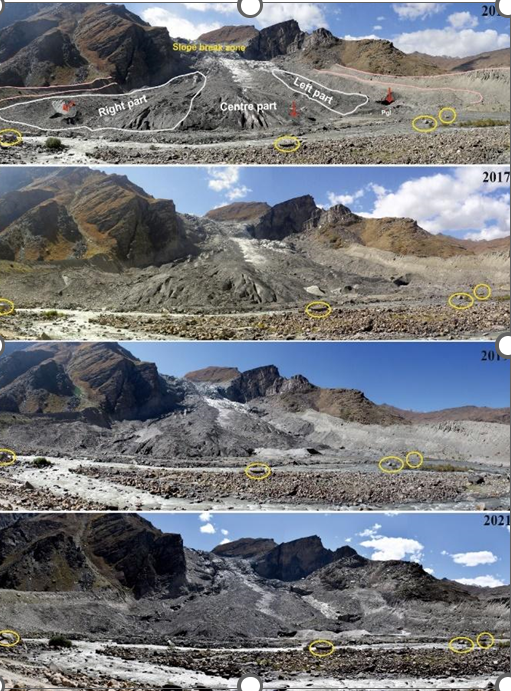
About:
- Parachik Glacier is a mountain glacier in Kargil, Ladakh.
- It is a mass of ice moving slowly down the Nun-Kun slopes.
- This ice mass falls finally into the Suru River.
- It is one of the largest glaciers in the Suru River valley, covering an area of 53 square km and is 14 km long.
- The Suru River valley is a part of the southern Zanskar Ranges in the western Himalayas.
- There are two main reasons for the rapid melting of the glacier.
- The first is global warming and increasing temperatures in the region.
- The second is that it is at a lower altitude than other glaciers in the Zanskar region.
- The research also estimated the surface ice velocity of the glacier, showing a reduction of about 28% in the lower ablation zone between 1999-2000 and 2020-2021.
Zanskar Ranges
- Zanskar is a high-altitude semi-desert lying on the Northern flank of the Great Himalayan Range.
- This mountain range acts as a climatic barrier protecting Ladakh and Zanskar from most of the monsoon, resulting in a pleasantly warm and dry climate in the summer.
Self-Reliant India Fund (SRI fund)
Tags: General Studies – 2 Government Policies & Interventions
Why in the news? As part of the Aatmanirbhar Bharat package, the Indian government announced a Rs. 50,000 crore Equity Infusion for Micro, Small, and Medium Enterprises (MSMEs) through the Fund of Funds.
- About: ve Investment Fund registered with SEBI.
- It aims to provide growth capital to the deserving and eligible units of the MSME sector.
- The total size of the fund is Rs. 50,000 Crore where Rs.10,000 Crore will come from the Government of India and Rs.40,000 Crore through Private Equity / Venture Capital funds.
- The SRI Fund operates through a mother-fund and daughter-fund structure for equity or quasi-equity investments.
- The NSIC Venture Capital Fund Limited (NVCFL) is registered as the Mother Fund under the SRI Fund implementation.
Other initiatives to support the MSME sector:
- It includes the launch of the Champions 2.0 portal, the MSME Champions Scheme for financial assistance, budgetary support to Credit Guarantee Fund Trust for Micro & Small Enterprises, and the “Raising and Accelerating MSME Performance (RAMP)” program aimed at strengthening MSMEs’ access to credit and markets and promoting technology upgradation.
RBI’s Digital Payments Index (RBI-DPI)
- Self-Reliant India Fund was set up in 2021.
- It is a Category-II Alternati
Tags: General Studies – 3 Economy
Why in the news? Digital payments across the country registered a growth of 13.24% in a year through March 2023, as per RBI’s index that measures the adoption of online transactions.
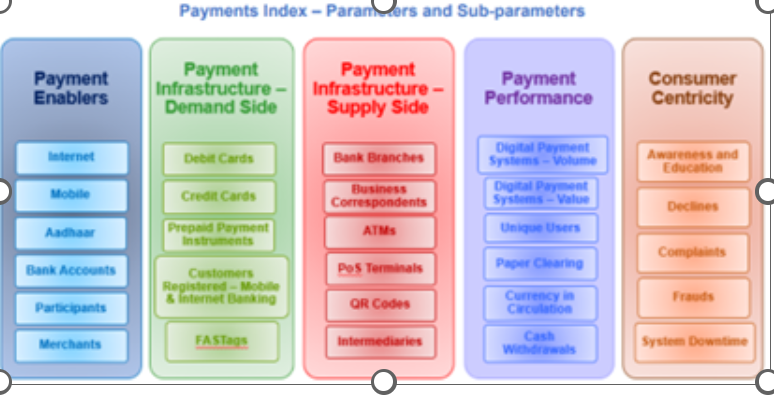
About:
- RBI’s Digital Payments Index (RBI-DPI) stood at 395.57 at March 2023 compared to 377.46 in September 2022 and 349.30 in March 2022.
- The increase in the index was attributed to substantial growth in payment infrastructure and performance across the country.
Digital Payments Index
- Digital Payments Index assesses the level of digitalization in payments nationwide and showcases the growth of different digital payment methods.
- It is released semi-annually and consists of five main parameters with varying weights:
- Payment Enablers (weight 25%)
- Payment Infrastructure – Demand-side factors (10%)
- Payment Infrastructure – Supply-side factors (15%)
- Payment Performance (45%)
- Consumer Centricity (5%)
- These parameters enable the measurement of the deepening and penetration of digital payments in the country over different periods.
Lao PDR (Laos)
Tags: General Studies –1 Geography, 2 Bilateral Groupings & Agreements
Why in the news? Recently, Five Memorandums of Understanding (MoUs) were signed between India & LAO PDR for the implementation of five Quick Impact Projects (QIPs) in the fields of education, health, water facility and IT.
About:

The MOUs were signed during the 3rd round of Foreign Office Consultations (FOC) held between India and Lao PDR in Vientiane.
India & LAO PDR share profound religious, cultural, and people-to-people connections stretching far back into history.
Lao PDR (Laos)
- Laos, is a landlocked country in northeast-central mainland Southeast Asia.
- Laos is bounded to the north by China, to the northeast and east by Vietnam, to the south by Cambodia, to the west by Thailand, and to the northwest by Myanmar (Burma).
- It is traversed by the Mekong River and is known for its mountainous terrain, French colonial architecture, hill tribe settlements, and Buddhist monasteries.
- The capital is Vientiane, located on the Mekong River in the northern portion of the country.
Niger
Tags: General Studies – 1 Geography
Why in the news? Recently, In Niger, the military coup has led to the detention of President Mohamed Bazoum.

About:
- Niger is a landlocked country located in West Africa.
- It is a unitary state bordered by Libya to the northeast, Chad to the east, Nigeria to the south, Benin and Burkina Faso to the southwest, Mali to the west, and Algeria to the northwest.
- Over 80% of its land area lies in the Sahara (Sahel Region).
- The capital of Niger is Niamey, which is also its largest city and serves as the political, economic, and cultural center of the country.
- Niger is predominantly covered by the Sahara Desert, and its landscape comprises a mix of desert, semi-arid regions, and savannahs.
- More in News: The coup plotters have named General Abdourahamane Tchiani as the new leader, citing security concerns related to jihadist violence.
Papua New Guinea
Tags: General Studies – 1 Geography
Why in the news? Recently, the Ministry of Electronics and Information Technology (MeitY) of India and the Ministry of Information and Communication Technology (MICT) of Papua New Guinea have signed a Memorandum of Understanding (MoU) to share INDIA STACK.
About:
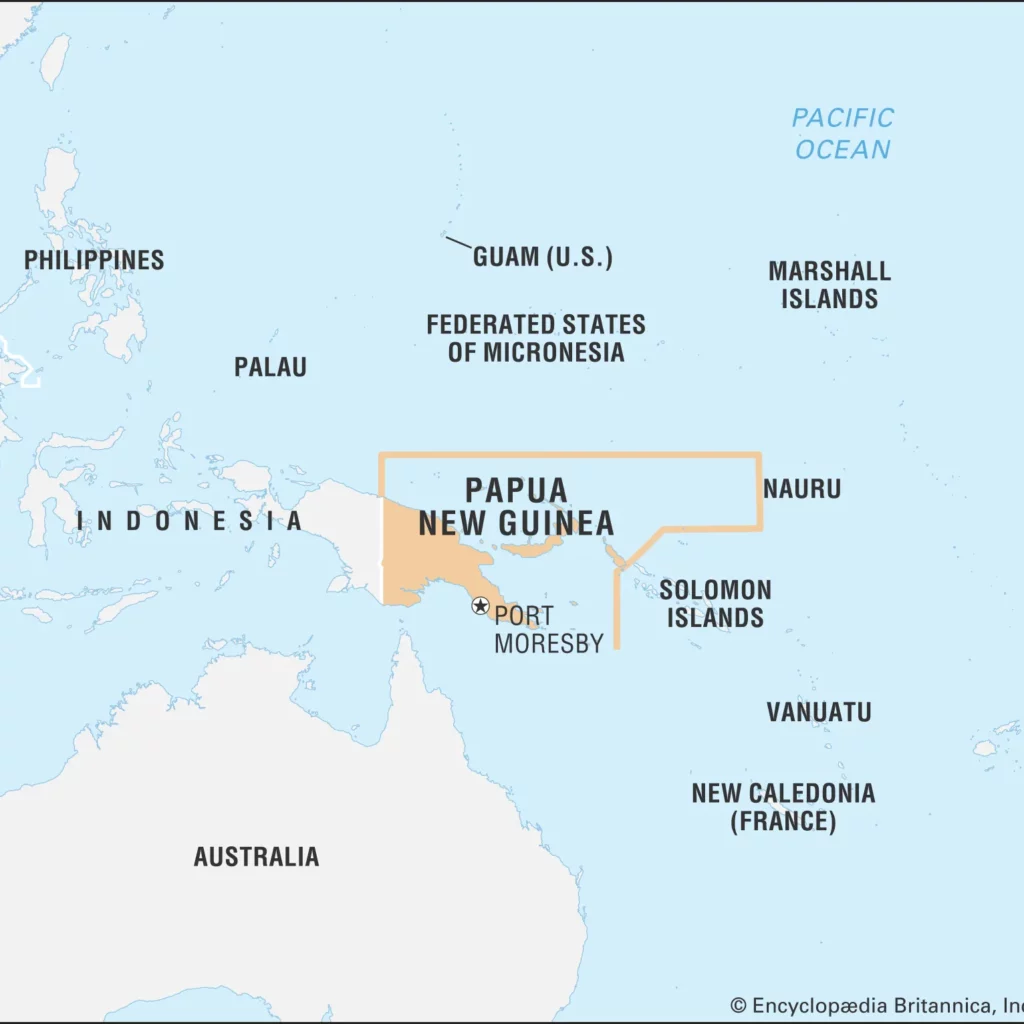
INDIA STACK is a collection of open APIs and digital public goods that aim to facilitate identity, data, and payment services on a large scale.
Papua New Guinea
- Papua New Guinea, an island country in the southwestern Pacific Ocean.
- It shares land borders with Indonesia and a water border with Australia, and the Solomon Islands.
- It includes the eastern half of New Guinea and many small offshore islands.
- The capital is Port Moresby, Papua New Guinea is mainly mountainous but has low-lying plains in southern New Guinea.
- A country of immense cultural and biological diversity, it’s known for its beaches and coral reefs.
Frequently Asked Questions (FAQs)
Q: What are daily current affairs?
A: Daily current affairs refer to the most recent and relevant events, developments, and news stories that are happening around the world on a day-to-day basis. These can encompass a wide range of topics, including politics, economics, science, technology, sports, and more.
Q: Why is it important to stay updated with daily current affairs?
A: Staying updated with daily current affairs is crucial because it helps individuals make informed decisions in their personal and professional lives. It enables people to understand the world around them, stay aware of significant events, and engage in informed discussions about important issues.
Q: Where can I access daily current affairs information?
A: There are various sources for daily current affairs, including newspapers, news websites, television news broadcasts, radio programs, and dedicated apps or newsletters. Social media platforms are also widely used to share and access current affairs information.
Q: How can I effectively incorporate daily current affairs into my routine?
A: To incorporate daily current affairs into your routine, consider setting aside specific times each day to read or watch news updates. You can also subscribe to newsletters or follow news apps to receive curated content. Engaging in discussions with peers or participating in online forums can further enhance your understanding of current events.
Q: What are some tips for critical analysis of daily current affairs?
A: When analyzing daily current affairs, it’s essential to cross-reference information from multiple sources to ensure accuracy. Additionally, consider the source’s credibility and bias, if any. Develop the ability to identify the main points and implications of news stories, and critically evaluate the significance and impact of the events reported.
In case you still have your doubts, contact us on 9811333901.
For UPSC Prelims Resources, Click here
For Daily Updates and Study Material:
Join our Telegram Channel – Edukemy for IAS
- 1. Learn through Videos – here
- 2. Be Exam Ready by Practicing Daily MCQs – here
- 3. Daily Newsletter – Get all your Current Affairs Covered – here
- 4. Mains Answer Writing Practice – here
Visit our YouTube Channel – here
